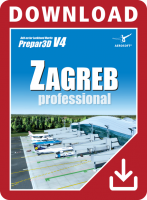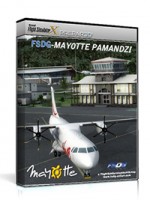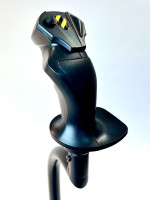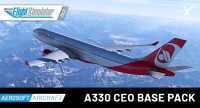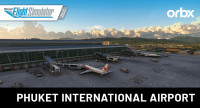Prezzi incl. 22% IVA
Disponibile come download immediato
- Numero Ordine: AS14871
- Publisher: A2A Simulations
- Lingua: English
- Versione corrente: 1.00
The Jack of All Trades and Master of All
The master of all trades? Well, perhaps that is a bit elaborate; however, the Cessna 182 is the proven master of a great many aeronautical “trades”, indeed. So, what are the “trades” that we want a General Aviation (GA) aeroplane to be the master of? Well, we want it to be fast, carry lots of fuel, people and baggage, climb well, stall gently, be easy to land and fly, be economical to operate and maintain, and generally be a safe and pleasant ride for us and our passengers - that’s a lot to ask of one aeroplane. After all, the physical world is based upon compromise and give and take; what is gained here is lost there, etc. Because of this necessary compromise, when it comes to mastering all of these “trades”, virtually every aeroplane fails to make the grade. Some exhibit very high performance but are a handful to fly for the average pilot and others are as gentle as a puppy, but do not perform so well. That ubiquitous physical compromise is present in most instances.
This version of the Accu-sim C182 Skylane is for P3D V4/V5 Academic only, please make sure that you have the right matching P3D version.
Lycoming 540 engine
Most A&P mechanics refer to the Lycoming 540 as being “bulletproof”. Consider that a Chevrolet big block in an early ‘70’s Corvette is 454 cubic inches, a Skyhawk’s engine is either 320 or 360 cubic inches (like small automobile V-8). The Skylane engine is 541.5 cubic inches, which is bigger than the previously mentioned Chevy big block. I have the same engine in my Comanche, and you feel this 50% bigger engine under the hood, just rumbling and rattling, waiting to be opened up on takeoff. We expanded Accu-Sim to capture the more aggressive nature of operating such a nice and powerful GA engine.
Constant speed prop – propeller physics
We upgraded the propeller physics for the Skylane in several areas. This was necessary to deliver the best experience when operating this new system. For example, many people don’t realize that a 2-blade propeller will generally cruise faster than a 3-blade at all but the very highest altitudes (and I’m talking where oxygen is required). The Skylane manual is based on the 3-blade, so you can squeeze out even more speed by using a 2-blade. The high cruise is just around 167 mph with a 3-blade, and around 170 mph with a 2-blade (keep in mind every plane will have slightly different cruise speeds, which speaks to the uniqueness of each airframe, engine, and prop). However, the 3-blade propeller will, in general, pull harder off the line and perform better in steep climbs. We also improved the modeling and sound of the propeller when it both flattens out and cuts into the air, which is most noticeable during prop checks on the ground.
Cruise management – beyond the book
This was an unexpected, but pleasant discovery when making the Skylane: Our cruise performance accuracy actually exceeds the pilot’s manual. Yes, we’re actually better than “by the book.” This is because some figures in the POH are calculated / estimated. For example, in Accu-Sim, you can realize the benefits of flying at lower RPM’s with higher manifold pressure, or “over square” (higher manifold pressure X 100 than RPM). Some pilot’s are still being told today that running a modern GA engine over square is bad, which is a technique recommended on some older, larger radial engines of the past. The fact is that most engines run better and more efficient at lower RPM and higher manifold pressure, rather than high RPM and low manifold pressure (just make sure you follow the guidelines in the pilot’s handbook for the airplane).
Accu-Sim models this efficiency, and we confirmed this on our actual flight tests. So, you will be experiencing the same differences from the POH with Accu-Sim than with the actual airplane. You will also find yourself thinking hard about your mixture, how it affects your cruise performance, temperatures, economy, etc., just like in the real aircraft. Just make sure, any real world pilots out there reading this that you follow the recommended cruise settings for your airplane because there is a limit to how much manifold pressure you are able to use at certain a RPM. Also, some engines require you to avoid certain power settings / RPM ranges due to vibration and balance issues. There is no one size fits all approach, but this Accu-Sim Skylane will certainly help both pilots and sim enthusiasts learn better flying skills and engine management practices.
Cowl flaps and advanced combustion physics
We further researched and developed engine temperatures, both cylinder head and exhaust gas temps. We also re-formulated the impact of mixture on the process and temperatures.
Expanded physical sound
The starter physics, engine starts, shutdowns, and in flight physics are pushed even further. Try playing with the throttle, or kicking the rudder at speed or doing a prop check. It’s a world of wonderful physics that drives our sound engine.
Hand towing
We added a new feature, turning your flight stick or yoke into a tow bar. It really gives the feel you are moving a large plane around, and you can put it exactly where you want it, however you wish. Our own Captain Jake said the other day “This towing is fun!” That’s a good sign coming from a 14 year old.
Features:
- A true propeller simulation.
- Experience the world’s most popular high performance GA airplane.
- Designed for both professional commercial pilot training and entertainment.
- Immersive pre-flight inspection system designed by pilots while operating the actual Cessna 182.
- Electric starter with accurate cranking power.
- Dynamic ground physics including both hard pavement and soft grass modeling.
- Primer-only starts are now possible. Accu-Sim monitors the amount of fuel injected and it’s effectiveness to start and run the engine.
- Persistent airplane where systems, corrosion, and temperatures are simulated even when the computer is off.
- Immersive in-cockpit, physics-driven sound environment from A2A engineered recordings.
- Complete maintenance hangar internal systems and detailed engine tests including compression checks.
- Piston combustion engine modeling. Air comes in, it mixes with fuel and ignites, parts move, heat up, and all work in harmony to produce the wonderful sound of a Lycoming 540 engine. Now the gauges look beneath the skin of your aircraft and show you what Accu-Sim is all about.
- Authentic Bendix King Avionics stack including the KMA 26 Audio Panel, two KX 155A NAV/COMMS, KR 87 ADF, KT 76C Transponder, KN 62A DME, and KAP 140 Two Axis Autopilot with altitude pre-selection.
- Three in-sim avionics configurations including no GPS, GPS 295, or the GNS 400. Built-in, automatic support for 3rd party GNS 430 and 530.
- As with every A2A aircraft, it is gorgeously constructed, inside and out, down to the last rivet.
- Designed and built to be flown “By The Book”.
- Visual Real-Time Load Manager, with the ability to load fuel, people, and baggage in real-time.
- Four naturally animated passengers that can sit in any seat including the pilot’s.
- 3D Lights ‘M’ (built directly into the model).
- Pure3D Instrumentation now with natural 3D appearance with exceptional performance.
- A total audible cockpit and ound engineered by A2A sound professionals.
- In cockpit pilot’s map for handy in-flight navigation.
- Authentic fuel delivery includes priming and proper mixture behavior. Mixture can be tuned by the book using the EGT or by ear. It’s your choice.
- All models include A2A specialized materials with authentic metals, plastics, and rubber.
- Airflow, density and its temperature not only affect the way your aircraft flies, but how the internal systems operate.
- Real-world conditions affect system conditions, including engine temperatures.
- Spark plugs can clog and eventually foul if the engine is allowed to idle too low for too long. Throttling up an engine with oil-soaked spark plugs can help clear them out.
- Overheating can cause scoring of cylinder head walls which could ultimately lead to failure if warnings are ignored and overly abused
- Engine, airframe, cockpit panel and individual gauges tremble from the combustion engine.
- Authentic drag from the airframe and flaps
- System failures, including flaps that can independently jam or break based on the actual forces put upon them. If you deploy your flaps at too high a speed, you could find yourself in a very dangerous situation.
- Authentic battery. The battery capacity is based on temperature. The major draw comes from engine starting.
- Oil pressure system is affected by oil viscosity (oil thickness). Oil viscosity is affected by oil temperature. Now when you start the engine, you need to be careful to give the engine time to warm
- Eight commercial aviation sponsors have supported the project including Phillips 66 Aviation, Champion Aerospace, and Knots2u speed modifications.
*This version is for academic users in Prepar3D, in accordance to the Lockheed Martin Prepar3D academic license. This software is to be used for flight simulation only, and not to be used for real world flight training. For real world flight training, use our commercial license which is intended to be used with flight simulators authorized by the FAA while using our software.
Lockheed Martin Prepar3D V4/V5 Academic*
Operating System: Microsoft Windows 10 (64bit)
Processor: Quad Core CPU with 3.5 GHz
Memory: 16 GB DDR4 RAM, 2666 MHz
Graphics card: 4 GB VRAM, DirectX 11
Free disk space: 2.1 GB, SSD highly recommended




.jpg)
.jpg)
.jpg)
.jpg)
.jpg)
.jpg)
.jpg)
.jpg)
.jpg)
.jpg)











